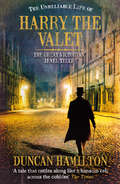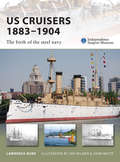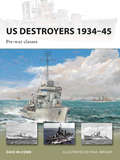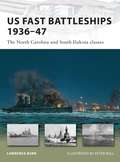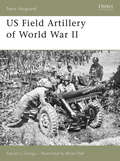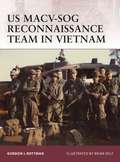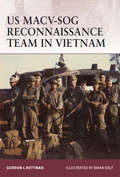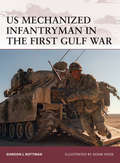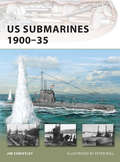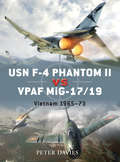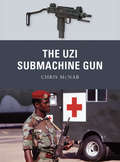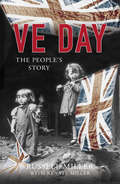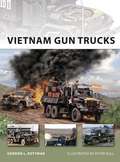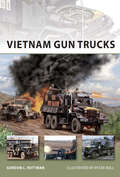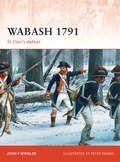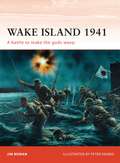- Table View
- List View
The Unreliable Life of Harry the Valet: The Great Victorian Jewel Thief
by Duncan Hamilton17 October 1898.An impossibly daring jewellery heist aboard a train at Paris's Gare du Nord station captures the attention of the world.Who would have dared to pull off such a feat?Award-winning writer Duncan Hamilton reveals the true story of Harry the Valet, the notorious crook who was the scourge of Victorian London.Harry conned and stole his way into high society, living a life of excess in London's best hotels and hang-outs. Dressed in bespoke suits and handmade shoes, Harry outwitted Scotland Yard with his trademark guile and panache.With dozens of pseudonyms, no fixed address and a knowledge of his city that allowed him to hide in its shadows, Harry seemed almost invisible. Until, blinded by love, he carried out the robbery that would prove his downfall.
US Cruisers 1883–1904: The birth of the steel navy (New Vanguard #143)
by John White Lawrence Burr Mr Ian PalmerBy the end of the Civil War the US Navy was the most advanced in the world, but in subsequent years America's naval might dwindled. However, in the 1880s a 'New Navy' was born and at the forefront of its fleet were the mighty cruisers. Naval historian Lawrence Burr details how these cruisers allowed America to rebuild their navy, exploring the design and development of these ships. Placing these advances in context, through vivid accounts of how US cruisers performed in the Spanish-American War of 1898, notably at Manila Bay and Santiago, he investigates the emergence of the US Navy as a major power. Illustrated with early photographs and full-colour artwork, this is a concise history of the birth and development of a modern navy that was the precursor to the development of modern steel fleets around the world.
US Destroyers 1934–45: Pre-war classes (New Vanguard #162)
by Mr Paul Wright Dave McCombSince the beginning of the 20th century, destroyers have been all-purpose ships, indispensable in roles large and small – from delivering the mail at sea to screening other vessels and, where larger ships were not present, forming the front line in battle. This title details the 169 ships of ten classes introduced in the 1930s: early 1,500-tonners and 1,850-ton destroyer leaders designed to conform to the 1930 London Naval Treaty, plus the successor 1,570-ton Sims class and 1,620and 1,630-ton Benson and Gleaves classes. In wartime, most 1,500-tonners and leaders initially saw front line duty in the Pacific but were relegated to secondary assignments as newer vessels arrived; while the later 1,620and 1,630-tonners became the standard destroyers of the Atlantic War. This volume reveals the fascinating design story behind these pioneering classes – from the constraints of peacetime treaties to advances in propulsion engineering, and wartime modifications. With an operational overview of their service and tables listing all ships by class, builder, and initial squadron, this is the definitive guide to the pre-war US destroyer classes.
US Fast Battleships 1936–47: The North Carolina and South Dakota classes (New Vanguard #169)
by Peter Bull Lawrence BurrThis volume details the design, construction, and operation of the first six of the ten US fast battleships, two of the North Carolina class and four of the South Dakota class. These six battleships were all authorized in 1936 and were the first vessels built in the US since 1923. Consequently, these ships benefitted from enormous technological leaps, with improvements in ship design, power, armor, armament and the single most important improvement the use of radar guided fire control helping to change the course of the war in the Pacific. Packed with first-hand accounts, battle reports, and specially created artwork this book tells the story of these war-winning vessels.
US Field Artillery of World War II (New Vanguard #131)
by Steven J. Zaloga Brian DelfDetermined to learn from the lessons of World War I, the US Army developed a new generation of field artillery weapons and tactics during the 1930s. Consequently, in World War II it was the clear leader in field artillery. Providing a thorough examination of the many critical innovations and doctrines, and the impact they had on performance, including the motorization of artillery, Fire Direction Centers, aerial observation, and radio communications. Exploring, in their entirety, the weapons that formed the backbone of the US artillery arsenal in World War II, this book reveals a wealth of detail not readily available elsewhere.
US MACV-SOG Reconnaissance Team in Vietnam (Warrior)
by Gordon L. Rottman Brian DelfIn 1964 Military Assistance Command, Vietnam, activated a joint unconventional task force known as the Studies and Observation Group-MACV-SOG. As a cover its mission was to conduct analysis of lessons learned in combat by all branches of service. SOG's real mission was to conduct covert strategic reconnaissance missions into Laos, Cambodia and South Vietnam as well as sabotage and 'Black' psychological operations. Ground, air and naval assets were employed to insert, collect, extract, and otherwise support these operations. This book tells the complete story of these covert agents, from their recruitment and training, through to their deadly black-ops in the jungles of Vietnam.
US MACV-SOG Reconnaissance Team in Vietnam (Warrior #159)
by Gordon L. Rottman Brian DelfIn 1964 Military Assistance Command, Vietnam, activated a joint unconventional task force known as the Studies and Observation Group-MACV-SOG. As a cover its mission was to conduct analysis of lessons learned in combat by all branches of service. SOG's real mission was to conduct covert strategic reconnaissance missions into Laos, Cambodia and South Vietnam as well as sabotage and 'Black' psychological operations. Ground, air and naval assets were employed to insert, collect, extract, and otherwise support these operations. This book tells the complete story of these covert agents, from their recruitment and training, through to their deadly black-ops in the jungles of Vietnam.
US Mechanized Infantryman in the First Gulf War (Warrior #140)
by Gordon L. Rottman Mr Adam HookIn many ways the end of the Vietnam War left the US army a spent force. Plagued by low morale, drug and race issues, and terrible public relations, the army faced an uphill climb in the effort to rebuild itself. The story of this reconstruction is mirrored in the rise of the Mechanized Infantryman. Deciding that the key to future conflict lay in highly trained and mobile warriors that could be delivered quickly to battle, the army adopted the mechanized infantryman as its frontline troops. This new, all volunteer force was given the best training and equipment. Most notably, they were to be deployed onto the battlefield from the new M2 Bradley Armoured Fighting Vehicle. This new breed of American warriors got their first test in the First Gulf War. Fighting in the deserts of Kuwait and Iraq, these soldiers proved that the US Army was once again a force with which to be reckoned. This book tells the story of the rise of the US mechanised infantryman, focusing on his recruitment, training, lifestyle and combat experiences in Iraq.
The US Military in Hawai’i: Colonialism, Memory and Resistance (Cambridge Imperial and Post-Colonial Studies)
by B. IrelandAn examination of how the US military in Hawaii is depicted by museum curators, memorial builders, film makers, and newspaper reporters. These mediums convey information, and engage their audiences, in ways that, together, form a powerful advocacy for the benefits of militarism in the islands.
US Submarines 1900–35 (New Vanguard #175)
by Jim ChristleyThis book introduces the reader to the early years of US submarine development and operation during the first third of the 20th century. It was in this period of growth and change that the submarine moved from a small vessel of limited range and tactical strength to a far ranging force. It also covers the little-told story of the United State's submarine force during World War I, and the lessons they learned that would be passed on to future generations of submariners.
USN F-4 Phantom II vs VPAF MiG-17/19: Vietnam 1965–73 (Duel)
by Jim Laurier Gareth Hector Peter E. DaviesThe Vietnam War placed unexpected demands upon American military forces and equipment.The principal US naval fighter, the McDonnell F-4 Phantom, had originally been designed to defend the Fleet from air attack at long range. However, its tremendous power and bomb-carrying capacity made it an obvious candidate for the attack mission in Vietnam from 1965 onwards. Its opponent was the MiG-17, a direct descendant of the MiG-15, which had given USAF Sabre jets a hard fight in the Korean War. This book brings to life their dangerous duels and includes detailed cockpit views and other specially commissioned artwork to highlight the benefits and shortcomings of each plane type. It was in the skies over Vietnam that many of the techniques of air combat evolved as pilots learned how to use and to defeat supersonic fighters for the first time.
The Uzi Submachine Gun (Weapon #12)
by Chris McNabThe Uzi submachine gun is one of the most recognizable weapons in history. Its familiarity stems in part from the sheer diversity of its users. Uzis have been seen being wielded and fired by US Secret Service agents and SWAT teams, Israeli soldiers, European special-forces, as well as criminals and terrorists the world over. The reasons they use the Uzi are simple – it provides devastating close-range firepower in a reliable, highly compact weapon. Weapon: The Uzi Submachine Gun tells the story of this unique weapon. It not only explores the gun's technical development and specifications, but also describes the and analyzes Uzi's combat use in a wide range of contexts, from Israeli soldiers battling on the Golan Heights in 1967, through to modern pirates operating off the coast of Somalia. This book presents the facts and challenges the myths surrounding this remarkable weapon.
VE Day: The People's Story
by Russell MillerDrawing from first-hand interviews, diaries and memoirs of those involved in the VE Day celebrations in 1945, VE Day: The People’s Story paints an enthralling picture of a day that marked the end of the war in Europe and the beginning of a new era. VE Day affected millions of people in countless ways, and the voices in this book – from both Britain and abroad, from civilians and service men and women, from the famous and the not-so-famous – provide a valuable social picture of the times. Mixed with humour as well as tragedy, rejoicing as well as sadness, regrets of the past and hopes for the future, VE Day is an inspiring record of one of the great turning points in history.
Vickers Valiant Airplane (large print)
by RnibThis is an image of a jet bomber seen from above. There is a locator dot shown, which will be at the top left of the page when the image is the correct way up. The image is in the centre and a scale in metres on the left of the page. The aircraft nose is in the top centre and the tail in the bottom centre of the page. The fuselage goes up and down the middle of the page. The cockpit is shown as a small curved window near the nose. The wings go out to the left and right. Sticking out from the bottom end of the wing there are two jet engine nozzles to the left and right of the fuselage. The bottom edge of the wing has four flaps on each side and the tail wing has one flap on each side. These are the ailerons used to manoeuvre the aircraft when it is flying. In the middle of each wing sticking out to the front of the wing is a fuel tank which is attached underneath the wing.
Vickers Valiant Airplane (UEB contracted)
by RnibThis is an image of a jet bomber seen from above. There is a locator dot shown, which will be at the top left of the page when the image is the correct way up. The image is in the centre and a scale in metres on the left of the page. The aircraft nose is in the top centre and the tail in the bottom centre of the page. The fuselage goes up and down the middle of the page. The cockpit is shown as a small curved window near the nose. The wings go out to the left and right. Sticking out from the bottom end of the wing there are two jet engine nozzles to the left and right of the fuselage. The bottom edge of the wing has four flaps on each side and the tail wing has one flap on each side. These are the ailerons used to manoeuvre the aircraft when it is flying. In the middle of each wing sticking out to the front of the wing is a fuel tank which is attached underneath the wing.
Vickers Valiant Airplane (UEB uncontracted)
by RnibThis is an image of a jet bomber seen from above. There is a locator dot shown, which will be at the top left of the page when the image is the correct way up. The image is in the centre and a scale in metres on the left of the page. The aircraft nose is in the top centre and the tail in the bottom centre of the page. The fuselage goes up and down the middle of the page. The cockpit is shown as a small curved window near the nose. The wings go out to the left and right. Sticking out from the bottom end of the wing there are two jet engine nozzles to the left and right of the fuselage. The bottom edge of the wing has four flaps on each side and the tail wing has one flap on each side. These are the ailerons used to manoeuvre the aircraft when it is flying. In the middle of each wing sticking out to the front of the wing is a fuel tank which is attached underneath the wing.
Vietnam Gun Trucks (New Vanguard)
by Peter Bull Gordon L. RottmanWhile Vietnam is usually perceived as an infantry war, with US forces deploying by helicopter, the long supply lines that led to their inland bases had to be traveled by ground vehicles. The 8th and 48th Transportation Groups were responsible for hauling supplies through the long, dangerous roads of Vietnam, and they often found themselves the target of ambushes, attacks, and sniping. In response to this, vehicle crews began to arm trucks with machine guns and armour them with sandbags. While these proved less than ideal, the concept was considered valid, and more and more "gun trucks†? appeared, sporting heavier weapons and armor. Written by a Vietnam veteran, this book traces the development of these gun trucks from the jury-rigged originals to the powerful armoured vehicles that appeared later in the war.
Vietnam Gun Trucks (New Vanguard #184)
by Gordon L. RottmanWhile Vietnam is usually perceived as an infantry war, with US forces deploying by helicopter, the long supply lines that led to their inland bases had to be traveled by ground vehicles. The 8th and 48th Transportation Groups were responsible for hauling supplies through the long, dangerous roads of Vietnam, and they often found themselves the target of ambushes, attacks, and sniping. In response to this, vehicle crews began to arm trucks with machine guns and armour them with sandbags. While these proved less than ideal, the concept was considered valid, and more and more “gun trucks” appeared, sporting heavier weapons and armor. Written by a Vietnam veteran, this book traces the development of these gun trucks from the jury-rigged originals to the powerful armoured vehicles that appeared later in the war.
Vietnam Infantry Tactics (Elite)
by Peter Dennis Gordon L. RottmanThis book reveals the evolving US, Viet Cong and NVA tactics at battalion level and below throughout the Vietnam War. Beginning with a description of the terrain, climate and the unique nature of operations in this theatre of war, the author, a Vietnam veteran himself, goes on to explain how unit organisation was broken down by combatant forces and the impact this had on the kind of tactics they employed. In particular, the author highlights how units were organised in reality on the battlefield as opposed to their theoretical tables of organisation. US tactics included the standard US tactical doctrine as prescribed by several field manuals and in which leaders and troops were rigourously trained. But it also reveals how many American units developed innovative small unit tactics specifically tailored to the terrain and enemy practices. In contrast, this book also reveals the tactics employed by Viet Cong and NVA units including their own Offensive Operations, Reconnaissance, Movement Formations and Security, and Ambushes.
The Violets of March: A Novel
by Sarah JioThe island has a way of calling you home... Ten years ago, Emily Watson was on top of the world: a best-selling novel, a husband plucked from the pages of a magazine, and a one-way ticket to happily ever after.Now her perfect life has crumbled and Emily is left to pick up the pieces.So when her great-Aunt Bee invites her to spend the month of March on her beloved Bainbridge Island, Emily accepts, longing to be healed by the sea. As she begins researching her next book, Emily discovers a red velvet diary, dated 1943, whose contents reveal a startling secret that could change her life forever... A heart-breaking story of love, hope and second chances, from the international bestselling author of All the Flowers in Paris
Vulcan - Long-range Medium Bomber (large print)
by RnibThis is an image of a jet bomber seen from above. There is a locator dot shown, which will be at the top left of the page when the image is the correct way up. The image is in the centre and a scale in metres on the left of the page. The aircraft nose is in the top centre and the tail in the bottom centre of the page. The fuselage goes up and down the middle of the page. The cockpit is shown as a tiny window near the nose. The wings sweep down to the left and right and are widest at the tail end. Sticking out from the end of the aircraft there are two jet engine nozzles to the left and right of the tail. The bottom edge of the wing has four flaps on each side, these are the ailerons used to manoeuvre the aircraft when it is flying.
Vulcan - Long-range Medium Bomber (UEB contracted)
by RnibThis is an image of a jet bomber seen from above. There is a locator dot shown, which will be at the top left of the page when the image is the correct way up. The image is in the centre and a scale in metres on the left of the page. The aircraft nose is in the top centre and the tail in the bottom centre of the page. The fuselage goes up and down the middle of the page. The cockpit is shown as a tiny window near the nose. The wings sweep down to the left and right and are widest at the tail end. Sticking out from the end of the aircraft there are two jet engine nozzles to the left and right of the tail. The bottom edge of the wing has four flaps on each side, these are the ailerons used to manoeuvre the aircraft when it is flying.
Vulcan - Long-range Medium Bomber (UEB uncontracted)
by RnibThis is an image of a jet bomber seen from above. There is a locator dot shown, which will be at the top left of the page when the image is the correct way up. The image is in the centre and a scale in metres on the left of the page. The aircraft nose is in the top centre and the tail in the bottom centre of the page. The fuselage goes up and down the middle of the page. The cockpit is shown as a tiny window near the nose. The wings sweep down to the left and right and are widest at the tail end. Sticking out from the end of the aircraft there are two jet engine nozzles to the left and right of the tail. The bottom edge of the wing has four flaps on each side, these are the ailerons used to manoeuvre the aircraft when it is flying.
Wabash 1791: St Clair’s defeat (Campaign #240)
by John F. WinklerThe battle of Wabash, or St. Clair's Massacre, was the greatest defeat of the American Army by Native American forces. The campaign opened in 1791, when an newly formed American Army, under the command of Revolutionary War hero, Arthur St. Clair, set off into the wilderness of Ohio in an effort to wrest control of the Northwest Territory from the various native tribes. Plagued by logistical problems, bad weather, and native ambushes, the expedition dragged on for months as the American army slowly eroded due to injury, sickness, and desertion. Then, on a cold November day, an allied Native army descended on the Americans. In the ensuing chaos, the Americans were slaughtered, taking over 90% casualties. In this book, author John F. Winkler, re-examines this one-sided victory, analyzing what the American's did wrong and how the Natives achieved a victory that they could never repeat.
Wake Island 1941: A battle to make the gods weep (Campaign #144)
by Peter Dennis Jim MoranOn the same day that the Japanese attacked Pearl Harbor, they also launched air attacks on Wake Island, an American marine and naval base in the Pacific. Three days later a Japanese invasion force stormed the island, but were bloodily repulsed by the scratch force of marines, sailors and even service personnel who defended it. Despite US attempts to relieve the island, the Japanese launched a much greater invasion a few weeks later and, despite gallant resistance, eventually caused the US Forces to surrender. This book tells the complete story of the vicious fighting on Wake Island, one of the near-legendary 'last stands' made by US military forces.
